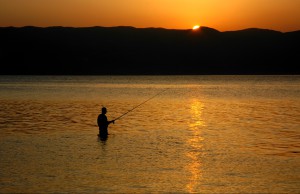Ah, Fly Fishing – the time honored pastime of ancient roman authors, military officers, and the everyman. You may want to join in on this time honored tradition, too! But are you concerned or hesitant because you don’t know where to start? Got the gear but can’t find the fish? Know fish habits well, but no idea how to cast your line? Well, read on – this series of posts will attempt to settle your concerns and get you raring to go connect with your inner outdoors(wo)man. First up? Understanding how fish behave. Special thanks to Fly Fishing for Beginners for compiling these tips.
General Fish Habits
Fish, much like any other species, want to survive. Therefore, they won’t be actively making your hunt any easier. If you want a successful catch, you need to know just how fish will behave in fishing waters. Whether it’s a lake or stream, here are some essential things to keep in mind:
Fish seek protection from predators in deeper water and natural debris (logs, bush, etc). They also tend to stick near the shade, where visibility is decreased. Another spot to watch is fast moving water, which also provides protection for some fish.
Fish will also be found near their primary food source– insects. To determine where the most insects are hanging about, look for the areas of the body of water that is receiving the most sunlight. More sunlight means more aquatic vegetation. And obviously, more vegetation means more food more insects which means… you get the picture. General rule of thumb: the banks usually get a lot of sunlight.
I’ve told you that fish can be found in fast moving water, so would you believe me if I said they also prefer slow moving currents? Just like us, fish have to work for food. While fish patter about in slow moving water, they will venture into the faster parts for nourishment. The trick is, to find the transition zone between the two. This is called a seam. Fish love seams.

